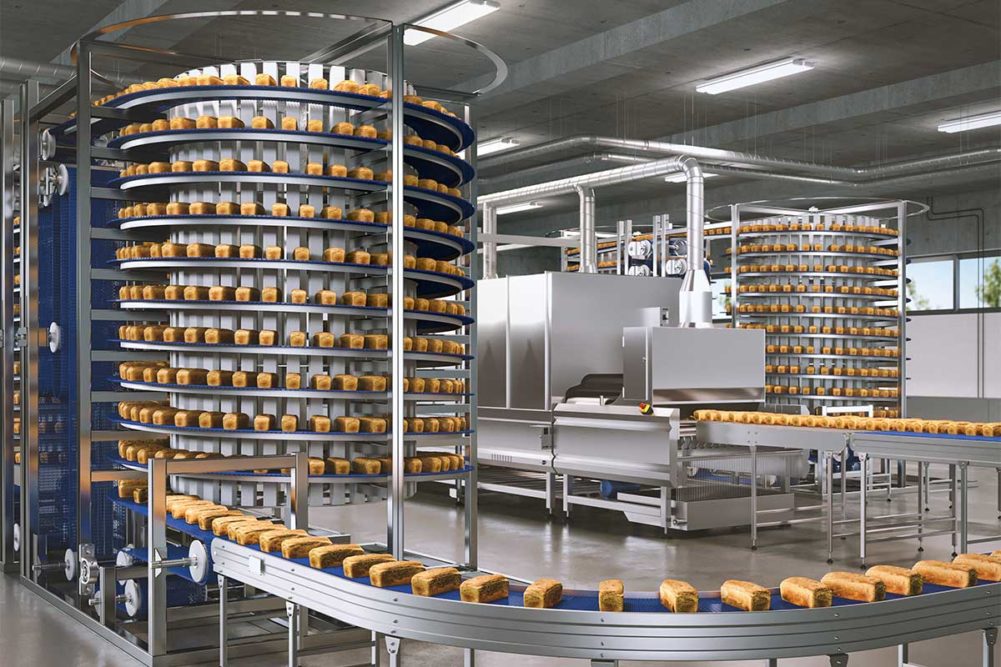Equipment experts enable bakers to ensure the integrity of conveyors for extreme temperatures. The differences must be accounted for in the belt and drive design, said Barry Voshell, strategic account manager at Regal Rexnord.
“Whenever possible, it is preferable to locate the drive of the adjacent conveyors away from the heat to allow the components to be a similar temperature where they engage with one another,” he said. “A mismatch of temperatures can cause tracking issues if not properly accounted for.”
Steel belts can be affected by temperatures if the heat is not distributed evenly across the belt, said Craig Bartsch, global sales and marketing manager, belts, IPCO USA.
“For example, if the left edge is 20 degrees warmer than the right edge, the belt tracking will be affected and the belt could track off and damage the edge,” he pointed out. “Another potential issue is not having the baked product all the way to the edge of the steel belt. If there is no product to absorb the heat, the belt will not track straight and could track off. The belt edges could also curl up.”
John Diver, engineer, Eaglestone Equipment, recommended a comprehensive analysis be conducted of all the components connected to the conveyors that will be exposed to extreme temperatures when setting up a conveyor system. It should include a look at the component lifespans and their permissible temperature thresholds.
“This proactive approach ensures the procurement of accurately specified parts, mitigating operational challenges for the end user,” he said. “Any uncertainties or inquiries should be promptly directed to the respective vendor or manufacturer, emphasizing the importance of preserving all relevant documentation, including calculations, vendor/manufacturer data and pertinent literature for future reference.”
Diver added that consideration of the National Electrical Manufacturers Association (NEMA) insulation class and computation of allowable temperature rise for motors and reducers is paramount. And bakers should be aware that high temperatures can impact the integrity of paint or specialized coatings on drive components.
He also said that once a risk assessment is done, safety measures should be incorporated.
“Throughout the design process, careful attention should be paid to ensure that the ergonomics of movement during various processes remain unhindered by the presence of guards or other safety measures,” Diver said. “In instances where access control is paramount, the implementation of fencing may be warranted. The adoption of lockout/tagout procedures in these designated areas is of paramount importance, facilitating the global or local cessation of system/line operations when necessary. Effective communication tools, such as signage, stickers and e-stops equipped with audible and visual alerts should be strategically deployed to ensure swift and comprehensible responses in the event of an emergency.”
Having a good understanding of the product that will be traveling on conveyors out of the oven will help bakers choose the right equipment, said Jerry Daly, sales engineer, Eaglestone Equipment.
“Is the product oily, sugary, soft or fragile?” he asked. “What is the temperature of the product when it exits the oven? The answers will direct the designer to use specific types of belting that will convey the product without damage and maximize the life of the belting.”
The material selected for a conveyor needs to work well not only for the food being produced, but also for its environment.
“Sometimes you want to have a belt that’s denser or more open,” said Jonathan Lasecki, director of engineering, Ashworth Bros. Inc. “Sometimes more metal is bad but sometimes more metal means the product will sink into the belt less. Or maybe it’s a plastic belt that you use or a hybrid belt. Depending on the product, you make sure you have a belt that the product can release from because product damage is always a loss. You want to prevent the product from getting damaged when it comes off.”
Understanding how the equipment is made allows bakers to make informed decisions about choosing the right materials as well.
“On the equipment, the wear tends to be focused on the belt and the support structure — the bed,” Lasecki said. “One or the other is going to wear, maybe both, so when I advise an OEM, if the belt takes the most wear, then their support structure needs to be harder. If it’s easier to change the belt, make the belt a little bit softer than the structure.’ ”
This article is an excerpt from the April 2024 issue of Baking & Snack. To read the entire feature on Conveyors, click here.




